30 September
2012
A Short History of f-holes
By Peter McCormack Close Encounters No Comments
A Short and Incomplete History Of the f-hole in Rickenbacker Guitars
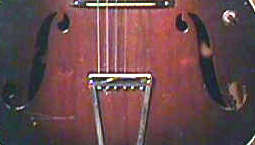
F-holes in 1930s Ken Roberts’ Model
The Early Years (1932-1950)
While collectors have been captivated by numerous design features of Rickenbacker guitars over the past seven decades, one of the most distinctive has been the f-hole. This decorative sound-hole has graced many a classical instrument over the centuries, allowing the scintilating sounds of violins and violas to make their full presence known to the audience. It is certainly fitting that Rickenbacker, a premier guitar-maker in the history of the instrument, included a graceful f-hole appointment in a number of their guitars beginning in the early 1930s.
The Electro-Spanish Model
Rickenbacker first introduced f-holes in the upper bouts of the hollow flat top body of the Electro-Spanish Model. This model was crafted from 1932-1935 with its neck and body made by Harmony of Chicago. It was initally without controls until 1934 at which time a single volume control knob adorned the body. There was one horseshoe pickup at the single saddle wooden bridge. The design for the Electro-Spanish f-holes closely resembled that seen in the National guitar line in the 1930s.
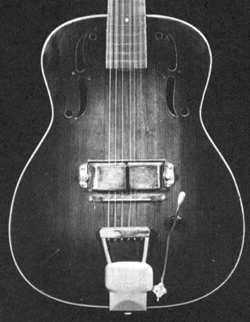
1934 Electro Spanish Model
f-holes in Upper Bouts
The Ken Roberts Model
In 1935 the Ken Roberts’ Model was introduced with f-holes added to the lower bout of the flat top body. The neck and body, as in the Electro-Spanish Model continued to be made by Harmony of Chicago. This model continued to has one horseshoe pickup with one volume control on the body. It was discontinued in 1940. Not only did the f-holes on the Ken Roberts’ model find themselves in the more traditional lower bouts of the body but it is also of interest to note that the pattern was different than that used in the earlier Electro-Spanish Model.

Ken Roberts circa 1937
f-holes in lower bouts
The Rickenbacker Spanish Model
The Rickenbacker Spanish Model (SP) was manufactured from 1946 until 1950 and crafted with f-holes in the upper bouts of an archtype body. Its bound fingerboard was appointed with block fret markers with its neck and body made by Harmony. Equipped with a horseshoe pickup at the wooden bridge, the body had two controls, one for volume and the other for tone. On this instrument, the f-holes returned to the upper bouts and the pattern used continues to evolve being different in shape compared to earlier models. This pattern would be seen to repeat itself in later Rickenbacker instruments although smaller in size.
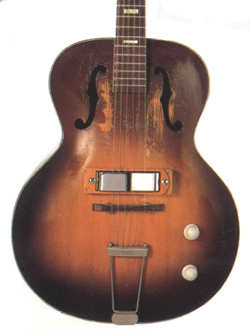
Rickenbacker Spanish circa 1948
f-holes positioned in upper bouts
The Rickenbacker S-59 Model
The Rickenbacker S-59 Model was manufactured from 1946 until 1950 and crafted with f-holes in the upper bouts of an archtype body. Its bound fingerboard was appointed with block fret markers with its neck and body made by Harmony. Equipped with a horseshoe pickup at the wooden bridge, the body had two controls, one for volume and the other for tone. For the S59 Model the f-holes resembled the shape seen in the Rickenbacker Spanish model although increased in size.
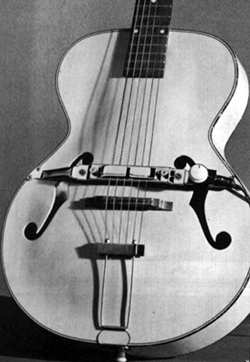
Rickenbacker S-59 Model
f-holes positioned in lower bouts
The Vintage Years (1958-1969)
The f-hole was not used to any significant degree during the 1950s by Rickenbacker, however, returned suddenly with the requests by Rose-Morris company in the United Kingdom around 1964. The Model 325 used by John Lennon of The Beatles sparked the interest of guitarists for Rickenbacker guitars in the UK and indeed worldwide. While there was no f-hole in Lennon’s guitar, the f-hole was a feature that was popular in other makes of guitars at the time and so Rose-Morris asked Rickenbacker to produce a line that substituted the f-hole for the traditional scimitar pattern seen in those instruments produced for America. The introduction of the f-hole was highly successful and this shape became synonymous with the British Invasion.
One O’Clock Versus Two O’Clock f-hole Position
The f-hole was introduced instead of the classic slash sound hole in a number of early 300 series guitars made by Rickenbacker. It is unlikely that Dick Burke could have imagined that the f-holes he produced in the 1960s would be the topic of much discussion nealy 40 years later. Indeed he described his work in a matter of fact way comparing the f-hole cut to the standard scimitar hole “It was the same instrument except for the f-hole – using the same jig. It was a simple job to change the f-hole in production, it just meant changing a few screws on the jig a putting in a new pattern.”
A close inspection of the shape and position of the f-holes produced during the 1960s revealed variation with regard to the shape of the sound hole as well as its orientation on the body. With the instrument placed in a guitar stand a straight on view revealed that some instruments had the f-hole position angled toward the one o’clock position and others oriented to the two o’clock position. While this indeed may have been a straight forward procedure for Dick Burke the results of the procedure did produce variation particularly with regard to the orientation of the f-hole.
Early Vintage Two O’Clock Position Examples
There are some Rickenbacker enthusiasts who have noticed that there is a trend in which f-holes in the two o’clock position were crafted in the earlier 1960s by Rickenbacker while those positioned at one o’clock appeared later in the 1960s. While this trend may hold up overall, it is worth noting that there were indeed earlier instruments that sported one o’clock position f-holes as well. Of one thing there is no doubt. Instruments from the 1950s and 1960s with f-holes are highly sought after by collectors and at present command higher prices at private sales and auctions. Early examples of those instruments with f-holes in the two o’clock position follow for 1958, 1958 and 1962.

1958 Model 325
f-hole at two o’clock
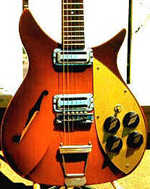
1959 Model 310
f-hole at two o’clock
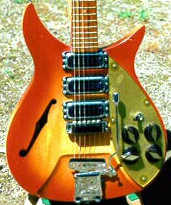
1961 Model 325
f-hole at two o’clock
Early Vintage One O’Clock Position Examples
There was indeed variability in the position of the f-hole in guitars produced in the earlier years of the Vintage period, from 1958 to about 1965. Examples of one o’clock f-holes in instruments manufactured in 1963 and 1964 are shown below. This serves as a reminder that not all instruments made in the relatively early British Invasion period had f-holes in the two o’clock position.
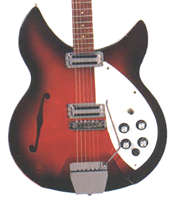
1963 Model 335S
f-hole at one o’clock
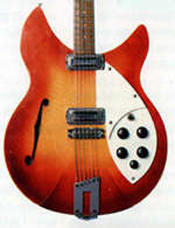
1964 Model 1993
f-hole at one o’clock
Late Vintage One O’Clock Position Examples
It would seem that it is far easier to find a late 1960s Rickenbacker with a one o’clock than a two oclock f-hole. An example of such an instrument is shown below, a nice example of a Model 310 from 1968.
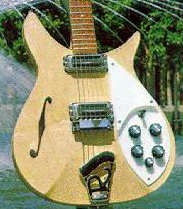
1968 Model 310
f-hole at one o’clock
Brief Summary Regarding f-hold Trends
An examination of the f-holes in Rickenbacker guitars since 1930 reveals that the position, orientation and shape of this sound hole was variable during the early years and during the “Vintage Years” as well. That sound holes moved from a two o’clock orientation to a one o’clock position is evident from the late 1950s to the late 1960s, however, there are many exceptions to this general “rule” as revealed in the photos chosen for this brief and as yet incomplete article. The vintage reissues are currently being examined and will be added to the text of this current article. As always, your comments are always welcome and will, without a doubt, shape the views expressed as of this date. Thanks to the contributors of The Rickenbacker Forum who sparked my curiosity in this area. Credit will be given to the owners of those instruments shown herein their identity has been determined. In the meantime, it is hoped that they will be patient or offer this information to the Rickenbacker Registration Page.
References:
- alt.guitar.rickenbacker Newsgroup
- Bacon, Tony and Day, Paul The Rickenbacker Book, 1994
- Rickenbacker International Corporation: Online Catalog Section
- Smith, Richard R. Rickenbacker: The History of Rickenbacker Guitars. Fullerton: Centerstream Publishing. 1987
- The Rickenbacker Forum
- The Vintage 325 Connection
